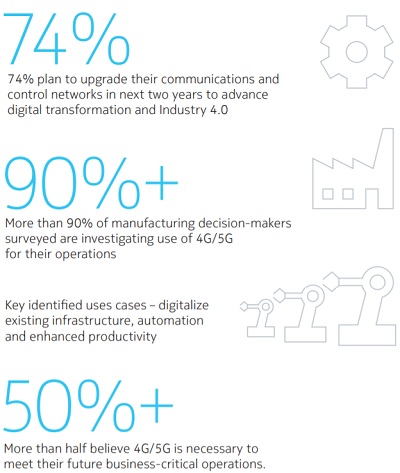Nokia partners with ABI Research to survey manufacturing investment in 4G/LTE, 5G and Industry 4.0
Research indicates need in every industry to quantify the potential ROI of investing in private wireless -- as well as the cost of inaction.

The survey found that 74% of respondents are looking to upgrade their communications and control networks by the end of 2022 with more than 90% investigating the use of either 4G and/or 5G in their operations. Just over half of respondents (52%) believe that the latest generation of 4G/LTE and 5G will be necessary to meet their transformational goals.
The research also identified key business use cases that would drive investment in 4G or 5G. Respondents reflected the need to digitalize and improve existing infrastructure (63%), automation with robotics (51%) and achieve new levels of employee productivity (42%).
Manish Gulyani, Vice President Marketing, Nokia Enterprise said: “We have reached an inflection point in Industry 4.0 transformation as the fast, secure, low latency connectivity underpinning its implementation now becomes available. This research indicates the strong marketplace appetite for industrial-grade wireless networking to capture the transformational benefits of digitalization and automation. We believe that demand, combined with easy-to-deploy private wireless solutions, will drive adoption.”
The research examined near-term drivers influencing buying decisions for new industrial systems across IT (information technology) and OT (operations technology). IT drivers primarily focus on reducing downtime (53%), improving operations efficiency (42%), and enhancing security (36%). In comparison, OT drivers reflect a desire to replace aging infrastructure (43%), improve efficiency (40%) and increase capacity (38%).
Further highlights indicate:
● 88% of respondents stated that they were familiar with private wireless (4G/5G) networking
● 84% that are considering 4G/5G will deploy their own local private wireless network in their manufacturing operations
● leading priority buying areas are automation and machine upgrades (47%), IIoT initiatives (41%), with cloud infrastructure following at (37%).
Ryan Martin, Principal Analyst, ABI Research said: “Importantly, research findings indicate a preference for deploying private fully-owned and operated wireless networks, with manufacturers favoring in-house management to allay security concerns. It’s evident that respondents are not entirely committed to Wi-Fi/WLAN and will consider latest generations of wireless technologies. As a result, 2020 is a critical year for networking suppliers to educate the market regarding the merits of 4G/LTE and 5G.
“Based on this research we also observe a pan-industry need to quantify not only the potential ROI of investing in private wireless, but also to clearly indicate the cost of inaction – vendors need to make the case for investing in Industry 4.0 today to gain a clear competitive advantage over those who choose to wait.”

Article Topics
Latest in Logistics
DHL expands its presence in Orlando with move into new facility Talking logistics trends and themes with Steve Huntley, President and Owner, Resource Logistics Group U.S. rail carload and intermodal volumes are down, for week ending June 17, reports AAR FTR’s Trucking Conditions Index shows modest improvement while long-term issues remain intact AAR report highlights ways in which railroads can play a key role in facing climate change FedEx finishes FY 2023 with earnings declines, amid signs of improvements OnTrac study looks at retailers’ needs for quicker deliveries as a competitive advantage More LogisticsSubscribe to Logistics Management Magazine

Find out what the world's most innovative companies are doing to improve productivity in their plants and distribution centers.
Start your FREE subscription today.
June 2023
万博2.0app下载

Latest Resources














